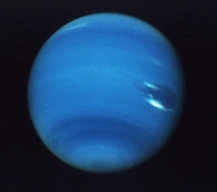 |
 |
|
|
|
 |
 |
| Basic Facts | |
| Neptune | The 8th planet from the sun |
| Color | Blue-green due to presence of methane in the atmosphere |
| Rings | Rings completely circle Neptune, thickness varies along its length |
| Average distance from the sun | 30.06 Astronomical Units (4.5 billion km) |
| Diameter | 49528 km |
| Length of year (orbital period) | ~ 60,000 days (164.8 years) |
| Rotation period | 19.1 hours |
| Inclination of axis | 29.6 degree |
| Mass | 1.02 x 10^26 kg (17.14 x Earth's mass) |
| Density | 1,638 kg/cubicmeters (0.3 x Earth's density) |
| Average temperature | 48 K (-255 degree Celsius) |
| Atmospheric composition | Hydrogen (74%), Helium (25%), Methane (1%) |
| Number of observed satellites | 8 |
| Names of satellities
(accending order according to distance from Neptune) |
Naiad, Thalassa, Despina, Galatea, Larissa, Proteus, Triton, Nereid |
| Planetary Nomenclature | |
| Neptune | Roman name for the god of the sea, equivalent to Poseidon, Greek god of the sea |
| Naiad | The name of a group of Greek water nymphs who were guardians of lakes, fountains, springs and rivers. |
| Thalassa | Greek sea goddess; mother of Aphrodite in some legends; others say she bore the Telchines. |
| Despina | Daughter of Poseidon (Neptune) and Demeter |
| Galatea | One of the Nereids, attendants of Poseidon |
| Larissa | A lover of Poseidon |
| Proteus | Greek sea god, son of Oceanus (or Poseidon) |
| Triton | The merman, half man, half fish son of Poseidon (Neptune) and Amphitrite |
| Nereid | The Mediterranean nymphs. The Nereids were the fifty daughters of Nereus and Doris and were attendants of Neptune. |
The story of Bishoujo Senshi Sailor
Moon used a lot of references to Greek mythology and astrology, and they
fitted in the story very nicely and properly. To learn about the
mythology and astrology behind Kaioh Michiru/Sailor Neptune, this is a good site:
Ganymede's
Palace, Ganymede's
Sailor Neptune Shrine.